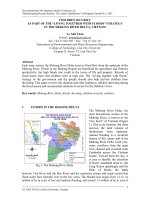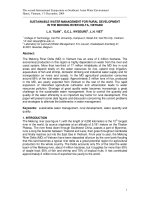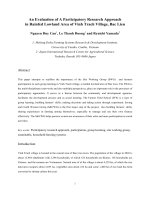Tài liệu An overview of the drinking water supply situation in the Mekong river delta, Vietnam pdf
Bạn đang xem bản rút gọn của tài liệu. Xem và tải ngay bản đầy đủ của tài liệu tại đây (357.3 KB, 10 trang )
-----------------------------------------------------------------------------------------------------------------------------------
An overview of the drinking water supply situation
1
in the Mekong river delta, Vietnam (Le Anh Tuan)
AN OVERVIEW OF THE DRINKING WATER SUPPLY SITUATION
IN THE MEKONG RIVER DELTA, VIETNAM
Le Anh Tuan, M.Eng. WRE.
College of Technology, CanTho University, Vietnam
E-mail:
------------------------------------------------------------------------------------------------------------
I. INTRODUCTION
The Mekong delta (MD), the most downstream part of the Mekong river (See figure 1), is
known as the biggest "rice bowl" of Vietnam. The Delta has a population of 17 million
inhabitants living in 4 million hectares of land. All the people living in the Delta have to
depend totally on the water resources, mainly the surface water, for domestic drinking,
crop irrigating, fish-shrimp raising, goods transporating and industrial producing. As a
general rule, any increase in industrial and agricultural activity from upstream may affect
to water quality problems more or less in the downstream.
As well as many other provinces in Vietnam, the MD are facing severe water problems.
Especially since last decade, parallel with the fast-growing economy, situation of pollution,
draught and flooding in the river are becoming worse more and more. To realize that the
health of the people is one of factors to ensure sustainable development of the country,
Vietnam government and international development agencies have implemented many
water supply and environmental sanitation programs.
Notice that, in the present time, about 75% of the inhabitants in the urban and 35% in the
suburban and rural have access to clean water, this figure drops to 20% in far and deep
areas. Since last 20 years to now, many drinking water plants and wells have been built.
Most of them are located in the cities, small towns and suburban. In the deep and far rural
areas, farmers still access water directly from rivers, canals, ponds or shadow wells.
The Center of Rural Water Supply and Environmental Sanitation in each province is found
since before 1990s and sponsored by UNICEF initially and Vietnam Central Government
later. Their responsible are to serve clean water for rural people. For urban, there is
Provincial Water Supply and Sewerage Company.
II. WATER SUPPLY SITUATION
II.1. Characteristics of water sources
In the MD, water is almost present all over. Water movement not only defines the
biophysical environment of the MD but largely determines the production options and
livelihood strategies of its inhabitants. For drinking water, there are 3 sources, i.e. rain
water, surface water and ground water. Depending on the location and the periods of the
year as well as the difference living conditions, the people should choice their own-ways
for collecting, storing and treating the water for domestic use.
• Rain water: is used as one of favorite drinking water sources, special in the rural
and suburban areas. In the urban places, rain water seems a minor source besides
the tap water. The quantitative change of annual average rainfall in the MD is
among 1,400 - 2,200 mm. About 90% of total rain water falls down the MD from
May to October. In the delta, the dry season extends for 7 months resulting in
serious shortage of rain water supply in many areas (See table 1).
-----------------------------------------------------------------------------------------------------------------------------------
An overview of the drinking water supply situation
2
in the Mekong river delta, Vietnam (Le Anh Tuan)
•
Surface water: is considered as a main source for water supply. Hydrological data
records show that, each year, approximately 500 billion cubic meters (or nearly
15,000 m
3
/s) have flowed out to the sea via the delta. High rainfall combined with
high flow of the river results in yearly flooding. Big flood occurs in the Mekong
river for every 2, 3 or 4 years. There is a very big different in discharge between
wet season and dry season. In the 5 months of the wet season, from May to
October, the river discharges 2/3 the total annual flow. The rest amount of river
flow is distributed in 7 months, from November to May, of the dry season (about
1,700 m
3
/s), from December to April. The low discharge of river water also leads to
the salinity intrusion and it becomes the major water use problem in the coastal
lands of the delta.
Saline encroachment effects almost half of the MD. The salinity is caused by sea water
intrusion in open mouths and estuaries. The phenomenon of salinity intrusion in the river
branches is very complicated. The main factors that determine this process are river
discharges, local rainfall and runoff, the tides and the depth of bars in the sea in front of the
estuaries. Otherwise, in early rainy season, nearly 1,6 million hectares of the delta are
infected by the acidity water due to the washing out aluminium and iron dissolve from the
acid surphate soil. Preventation saline water intrusion to depression may cause a potential
acid surphate soil become an activity acid surphate soil upon drainage and oxidation.
Water quality of the Upper Mekong river is good with slightly alkaline, small dissolved
salt content, and low potential toxic ions. The river carries 250 million ton of sediment per
year. Sediments are rich in nutrients for agriculture cultivation but they are one of the
drinking water treatment problems also. The sediment load of the river isnot so high if
compared with Red river in the North of Vietnam. It is highest during the rise in discharge
during the flood season. Few data is available, but in August - September the sediment
content, considered as total dissolved and suspended solids, would be about 300 mg/l,
thereafter less than 50 mg/l. An Giang, Dong Thap, Can Tho and Vinh Long, that are
provinces located on the upper Mekong River, can get greater convenience for building
surface water treatment plants.
Data on small streams are scare, water quality however may vary consisderable. Rapid
growths of industrialisation and urbanisation are leaded to increase water demand and also
caused surface water pollution. Some streams flow through provinces/ cities and towns
may be polluted by toxic chemicals at industrial production plants or domestic used waters,
microbiological and biological aspects, insecticides,... There is no wastewater treatment
plant in the city, except some wastewater treatment works in industrial zones.
The project of fresh-watering the Ca Mau Peninsula to be invested in enlarging irrigation
systems, widening channels and canals, building drains, dikes, tanks, controlling salted
and acid surphate soil areas in the western and coastal part of the delta for increasing rice
cultivation areas and improving the water supply to the people. So, implementating theses
project objectives are to seem difficulty due to many limited factors, such as capital
lacking, environmental impacts, conflicts between rice farmers and shrimp farmers, project
manager's skill, ...
Operation of water control system may have some disease incidence caused by altered
hydrological regime. Water flow is one of important factors in transmission of diseases in
-----------------------------------------------------------------------------------------------------------------------------------
An overview of the drinking water supply situation
3
in the Mekong river delta, Vietnam (Le Anh Tuan)
rural areas. Intestinal infections diseases including diarrhoea and dysestery occur more
generally. Malaria and Dengue fever is seem common thoughout the delta, especially in
backish and stagnant water areas, like Ca Mau, Bac Lieu, Tra Vinh, ...
• Groundwater: is widely used in the many provinces along the coastal areas.
Source of ground water is plentiful and present all over the delta. Ground water is
exploited and pumped from 2 depth levels: at 80 - 120 meters for household wells
and at 400 - 500 meters for groundwater plants (See Table 2). The upper level
water is widely drilled and pumped out. UNICEF pump is commonly used but the
water meet many problems with salinity and too high iron content. Salt water
infiltration into ground water is very common in the coastal areas in the MD like
Tien Giang, Ben Tre, Ca Mau, Kien Giang, etc. Although a lot of the wells have
experienced quality problems of some kind - pH, high iron content, salinity and bad
smell being most common - almost all plants for the future are based on increased
groundwater withdrawal.
The lower level water is better quality but it is costly in
exploitation. Nevertheless, drilling the well very deep is necessary to be
recommended.
II.2. Drinking water collection, treatment and distribution
Depending on the mean, place and time for water quality and quantity, the Mekong people
have many ways for collection and treatment (See figure 2). Concerning the water supply,
major problems in the delta, which effect people's living standards and health cares
include: shortage of fresh water, salt water intrusion, acid surphate soil, industrial and
agricultural pollutions and lacking capital for water treatment and system distribution.
Moreover, sustained development of the MD is threatened by large scale destruction of
mangroves for shrimp cultivation that leads to the pollution of the estuarine water bodies
and in the future possible by overexploitation and un-calculation of groundwater aquifer.
Even minor changes to local water management technologies may have unexpected and
far-search impact on the hydrological environments of the neighboring locations.
• Collecting rain water for domestic use is a traditional way in the MD. Storage of
rain water in terra-cotta jars and cement-brick tanks or in large concrete containers is very
common in rural, sub-urban areas and islands. The advantages of rain water in the MD are
almost clean, purpose, easy to collect and very low cost. However, rain water is too short
in the dry season and its storages are rather inoculated the mosquito pathogens or insect
ovum. Otherwise, when falling from the air and flowing on the house roofs, arris-gutters
rain water may be polluted by air-dust, bird-guano, ... A few of rain water analysis have
recorded the acidity in the rain water in April, May yearly. No using of rain water in early
rainy season is recommended as way to treat the air-dust and other pollutants deposited in
the house-roofs after a long period of dry season.
• Freshwater from river and canal is widely used in the upper parts of the delta,
where the water quality isnot effected by high concentration of salinity and/or acidity
and/or pollution. In An Giang and Kien Giang, building reservoirs in high lands for
keeping stream water is one of the water collection ways.
Commonly, surfate water taken from the rivers and streams is settled in settling tanks and
then treated by aluminium sulphate (alum) and sand filter techniques. Finally, chlorination
is used as a disinfectant. The purpose of sand filtration is to separate solid and liquid
mixture. Alum treatment is used commonly in the delta for decreasing turbidity. This
-----------------------------------------------------------------------------------------------------------------------------------
An overview of the drinking water supply situation
4
in the Mekong river delta, Vietnam (Le Anh Tuan)
chemical treatment will make surface water more clarify due to remove total suspended
matter. Both sand filter and alum treatment are effective ways to remove total coliform
bacteria as well. Depending on the special technical and financial conditions, gravity or
pressure filtration, rapid or slow filtration will be chosen. Filter media are sand (size of 0.2
- 1 mm), gravel, activated coat, porous material or film are commonly used. Alum has been
popular as a coagulant in treatment processes in the Mekong for quite a long time. In rural
areas, villagers buy alum in solid form and stir it into river water in the storage jars. After a
few minute stirring, the flocci are settled at the bottom of the jar. However, surface water
treatment such as filtration and coagulation cannot ensure complete removal of the smallest
bacteria and viruses as well as toxic matters from industrial and agricultural wastewater.
• Ground water is the main source for the lower parts of the delta such as coastal
areas and poor water-distribution places. In rural water supply, the opinion the
groundwater is the preferable choice is widespread both among staff working with water
supply and villagers. In the MD, ferrous iron (Fe
2+
) is found in groundwater commonly. It
cause metallic taste and bad smell. Groundwater is pumped out and can be treated by
aeration and filtration. Aeration is used to change iron content ferrous to ferric form (Fe
3+
)
and to reduce tastes and odours.
• Depending on the financial and management capacity, water suppliers can choice
one of filtration processes, such as slow sand filter or pressure filters or upflow filters.
Both surface and ground water are collected by electricity or hand pumps. Water Supply
Plants are governed and placed in the cities and towns (see figure 3), all are the State-
owned water suppliers. Treated water are stored in water tanks and distributed to
households and other water users by pipe network mainly in cities, sub-urbans and small
towns. Only 40 per cent to 50 per cent of the residents in the Mekong Delta have receive
clean water from the State water plants.
According to NEDECO data sources: The clean water production for 15 towns in the Delta
was some 142,000 m3 in 1990, of which some 40% was unaccounted for; ground water
took a share of 41,000 m
3
/day. The urban demand was estimated at 245,000 m
3
/day.
Industrial water use is estimated at 34,000 m
3
/day, entirely from ground water. In the rural
area, some 19,500 small wells have been drilled with an abstraction capacity of 90,000
m
3
/day for water supply of about 2.6 million people.
• In accordance with a decision of Vietnam Government, from 3/2000 and depending
on purpose of use, tap water prices were raised by 24.4% to 69.9%. New prices is listed as
table 3. New charges seem no effect to the high income groups but it is really a problem
for the poor communities.
III. DISCUSSION
Water in the MD is necessary to discuss in all its aspects. Although the amount of water on
the delta is large if compared others regions on the world, but the capacity of clean water
supply is finite in general and the demand is increasing due to a growing population,
industrialisation, urbanisaltion and living standard.
• Water supply is become a potential developing market in the MD. In last ten years,
Vietnam Central Government invested US$ 1.3 billion into doubling the nation's water
supply network. Besides the water supply projects built by the national budget, others are
-----------------------------------------------------------------------------------------------------------------------------------
An overview of the drinking water supply situation
5
in the Mekong river delta, Vietnam (Le Anh Tuan)
generally funded through international organisations such as WB, ADB, UNICEF, UNDP
and donor nations such as Finland, Denmark, France, Japan, the Netherlands, Australia,
Sweden, South Korea and Germany. Looking at urban markets anywhere, we can count
more than 20 trade-marks of bottled drinking water. This presents an increasing of number
of drinking water suppliers if compared with a little number of them in the last decade.
Water supply is as planned table 4 and table 5.
•
It is notice that water loss in water distribution systems is rather high, especial in
the big cities. Up to 40%, even more, of water in Can Tho, Vinh Long, Long Xuyen and
Ca Mau were lost through wastage or inefficiency. Average water loss stands at about 37%
in the whole. In whole country, major causes of unaccounted for water as identified by
provincial water companies, are: leaks in the distribution system; faulty meters and illegal
taps (VN Water & Sewerage Ass. 2002), (See figure 4).
•
Pollution of water both surface and ground had led to a decreasing amount of water
available for use. It really threat the sustainability of the country if we have no any way
and mean to control and to improve. It is necessary to balance water supply and demand
based on the economical/ social/ environmental objectives of maximizing net benefits of
water use.
• Being poor means limited capital resources to invest in living standard
improvement related to clean water and environment. High prices of water supply will
limit the number of water users in poor households.
• Decentralised water supply for rural communities is recommended. Development
many small drinking water treatment plants inside or nearby communes or districts may
get a low cost on construction, a simple on distribution and an easy on management.
• Environmental education programmes should be introduced to the schools,
communities widely. Mass communication media should have a role on raising people’s
awareness of water protection also. Others, a guidance how to save the tap water is also the
way to decrease the water demand.
• Socialisation and privatisation of the water supply systems should be encouraged
and conducted.
• The need for international collaboration and donor agencies to support the drinking
water treatment technology, to train the water related staff and to facilitate cost-effective
development is clear.
• Other far and wide problems such as gender development, poverty alleviation,
climatic change, globalisation and liberalisation of trade, etc. related water supply should
be put forward for public discussions further and later.
Le Anh Tuan
March, 2003









